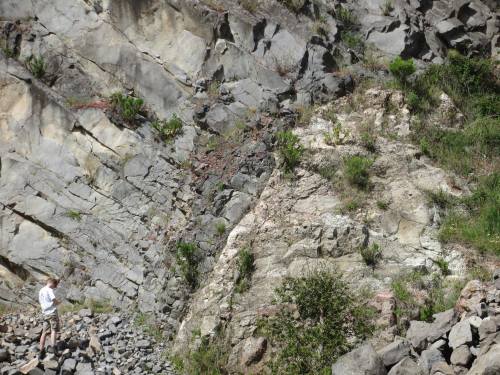Xenoliths and Xenocrysts: An example of the rockhound mindsetLet me start by saying this: I love vol
Xenoliths and Xenocrysts: An example of the rockhound mindsetLet me start by saying this: I love volcanic rocks. As a child, when everyone else was reading Princess Diaries or Alex Rider, I was sat with a Dorling Kindersley book on Volcanoes drinking in every word. If my 5ft 7 stature and size 8 feet didn’t set me out from every other 12 year old my choice in literature surely did.So you can probably imagine my excitement when on a university fieldtrip my lecturer took us to a quarry filled with igneous rocks. It was a myriad of cross cutting, intruding bliss and the perfect place to collect some samples.Approximately one year earlier I had had a rather horrifying run in with a scree slope, whereby a landslide (more specifically a metre across block of sandstone) nearly bludgeoned me to death while I desperately clung onto slope and prayed. I was therefore wary of ever climbing on scree again and avoided such experiences at all costs.Despite this, and before my best mate could even remind me of the prior incident, I was sprinting across the quarry floor and vaulting up the base of the scree. All thoughts of near death had left my mind, I was solely focussed on the samples I knew would be lurking amongst the rubble. I was found 15 minutes later covered in rocks, trying to convince my friend that if I left all my belongings behind I could totally carry all of the samples back home without having to pay for extra baggage allowance on the plane.So what is so cool about xenoliths and xenocrysts? Well they are pieces of foreign rock (xenoliths) or cystals (xenocrysts) that have become trapped or entrained within an igneous rock. These fragments can be sedimentary, igneous or metamorphic in origin and can range from a chunk of country rock (the already in-situ strata the igneous body is moving past/through such as the white coloured rock in the first picture) to pieces of the mantle.Now I wouldn’t have vaulted up a scree slope for a chunk of any old rock. These rocks were mantle xenoliths meaning the samples contained inclusions of peridotite with xenocrysts of olivine and pyroxene. These were actual fragments of the mantle that you could hold in your hand and study, kind of useful when the mantle usually sits 35km beneath your feet.Some people would have suggest that rather than risking life and limb I could have purely bought a sample from a shop. After all, most rock shops contain peridotite samples and even jewellers will sell rings adorned with olivines. However, as most rock hounds will tell you, buying rocks is tantamount to cheating. Rock collections collected by hand from obscure locations that took the owner hours to find will always be treasured far greater than any collection bought from a shop.The daring tale of how you found the sample will always increase its value, at least in the eyes of fellow rockhounds. In the eyes of my mum it is all rather ridiculous but then again she is the one that currently has boxes of rocks crowding out her study. One of the many advantages of living with a rockhound.- WatsonImage Credit: WatsonReferences:http://bit.ly/1G4r3f2Further Reading:http://bit.ly/1G4r96t -- source link
#xenolith#xenocryst#rockhound#geology#geologist#science

